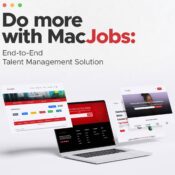
Brain Drain and Your Organisation: How to Mitigate the Impact
Brain drain refers to the loss of talented and skilled employees due to internal factors such as poor remuneration or culture, poor career prospects, lack of recognition and lack of opportunities for professional development.
In addition to internal factors that can significantly impact employee retention, external factors such as a country’s economic environment contribute to turnover within an organisation.
In a recent MacTay survey on how business owners and HR professionals can entice their best minds to stay during this “japa wave”, 40% of respondents said they would offer attractive perks, while another 21% cited an increase in compensation as a critical factor. But is that enough?
In the same survey, 35% of respondents said they would “wish their best employees good luck” if they decided to toe the japa lane.
Now the question is: Is the japa culture (brain drain) a function of a failed corporate culture or a reflection of the current state of the nation? If the latter, should companies be exonerated as contributors to this recent trend?
“I have come to the realisation that most japa movements have nothing to do with corporate culture but the state of the country,” says Aanuoluwapo Oyewale, a Lagos-based data analyst. Adebayo Ogunleke retorted, “the current economic instability in Nigeria is the main cause of this “japa wave” and not the companies.”
But what does this mean for businesses in Nigeria? You can offer attractive perks, competitive salaries and an inclusive environment and culture, but all this may not be enough to prevent your best minds from leaving your company.
If this is the case, what concrete measures can companies take to mitigate the impact of brain drain on their business? How can they stem the tide?
In this post, we have highlighted four practical steps employers can take to ensure they continually have a robust pipeline of quality talent that can support their business growth in times of uncertainty.
#1. Use the services of recruitment process outsourcing

Benefits of recruitment process outsourcing (RPO). Image via Softonehr.
When talented employees leave to pursue opportunities elsewhere, companies must adjust accordingly and ensure that they have a steady supply of quality talent to fill the gap left by departing employees.
One of the best ways to do this is to outsource your recruitment and hiring processes to an RPO provider who can help you develop a comprehensive sourcing strategy and deploy efficient talent acquisition techniques so you can hire top talent.
By partnering with an RPO provider, companies can:
- Tap into a global talent pool of ready-to-go candidates and improve your chances of retaining the best people, even in industries susceptible to talent churn.
- Objectively assess candidates using data-driven methods that take into account a range of factors such as skills, experience and potential.
- Build a strong employer brand that attracts top talent and cushions the impact of employee departures.
- Provide ongoing client support after the initial placement to ensure your company’s hiring needs are continually met.
- Keep abreast of the latest recruiting trends, including technology, automation and digital recruitment techniques to source top talent.
Related reading: Recruitment Process Outsourcing (RPO): What It Is And How To Get Started
#2: Take advantage of employee outsourcing solutions

Employee outsourcing services. Image via Infosearch BPO.
Brain drain (human capital flight) creates a gap in workforce management because you lose valuable knowledge, expertise and experience when valued employees leave your organisation.
Companies can counteract this by hiring and training new talent, but this can be both time-consuming and costly.
To mitigate this situation, companies can take advantage of employee outsourcing solutions that allow them to leverage the skills and experience of highly skilled professionals who are in demand at a fraction of the cost of hiring a new employee.
By using outsourcing models such as flexible staffing and project-based engagements, you can access top talent to augment the gap left by departing employees.
In addition, employee outsourcing enables companies to strategically align with changing business needs and helps them bridge the gap between talent departures and recruitment.
This process is thus a cost-effective way to address the challenges of retaining top talent and helps you access professional expertise even in times of change.
Related reading: The Ultimate Guide to Employee Outsourcing in Nigeria
#3. Improve your talent acquisition strategy

Talent acquisition strategy. Image via Cielo Talent.
Implementing a talent acquisition strategy is critical to the success of companies reeling from the effects of brain drain.
This strategic approach to attracting and retaining talent must take a top-down, executive-led approach to persuade skilled employees to stay while curbing churn.
Top of the list should be strengthening employer branding efforts and investing in attraction campaigns to attract top talent to the company.
Similarly, companies need to develop and implement a robust sourcing strategy and continuously monitor the effectiveness of their employer brand through market research, employee surveys, etc.
These measures will improve the quality of candidates interested in working for your company, increase employee engagement and productivity, and lower staff turnover.
In addition, the role of talent managers must also evolve to nip this trend in the bud by developing enterprise-level talent management practices that address the complexity of talent churn, manage talent flow and create brain gain.
Related reading: Winning At Talent Acquisition in 2023: The Complete Playbook
#4. Embrace organisational change management
John Kotter, an award-winning expert on leadership and change management, in his groundbreaking book: “Accelerate: Building Strategic Agility For a Faster-Moving World” developed eight phases for managing organisational change.
He affirmed that successful change management efforts usually begin with leaders examining the market for changes that may lead to new competitive conditions for the organisation.
These changes may result from demographic shifts, social trends, new technologies, market or competitive changes, or new government regulations, the Harvard Business School professor said.
However, in the context of organisational brain drain, change management can help companies identify the causes of talent churn and develop strategies to retain key employees. This could mean improving working conditions, offering more training and development opportunities, or increasing salaries and benefits.
In addition, change management can help companies adapt to the loss of key employees by making changes to organisational structure, culture, processes or other aspects of the business.
By understanding and managing the impact of change, companies can ensure that they remain productive and successful even under difficult conditions.
Related reading: How Ready is Your Organisation For The Future of Work?
The way forward
The brain drain “japa wave” is a growing phenomenon in Nigeria, leading to a widening skills gap in the labour market that businesses can no longer turn a blind eye to.
MacTay is well positioned and equipped to help businesses bridge their talent and workforce gap with bespoke staffing solutions that combine our in-depth knowledge of the Nigerian business environment with the latest technology to deliver outstanding results for our clients.
To learn more about our services and how we can help prevent a persistent talent shortage in your organisation, please schedule a consultation with our team today.










